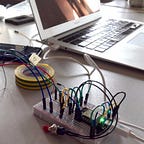Part 6: Shooting a movie
We all have limits to our abilities — physical, social, emotional and cognitive. How can we design to embrace these universal things that make us human, but also create solutions that are highly adaptive to an individual person?
We as designers can help to remove obstacles, enabling people to participate in society no matter their individual challenges. Let’s imagine a future that puts human empathy at their design core!
This is a work-in-progress documentation of a design project on the topic of inclusion and technology. We as a group of design students are working on design for the blind as part of a collaboration between Microsoft Research and University of Applied Sciences Potsdam. More background information at the bottom.
The idea behind the movie
The idea behind Polo can be difficult to grasp by description or infographic alone. To illustrate how Polo works from a user perspective, we therefore decided to shoot a short movie clip, quickly making a point for the importance of autonomous, hassle-free grocery shopping for the blind.
The movie reflects on the user’s journey through the grocery store, picking up any item he or she has on the list as well as exploring yet unknown products along the way.
We also intend to bring across that while Polo provides a reliable and hands-on experience to the user. It is also unobtrusive, hiding the visual impairment rather than emphasizing it as medical devices oftentimes do.
Searching for a grocery store to film in
As we aimed for a live action movie instead of animation only, it was clear from the beginning that we need a supermarket for on location shooting as well as an actor or actress and a good looking prototype of Polo.
Convincing supermarket chains of a permission to film can be tough and time consuming. You are likely to end up in the bureaucracy hurdles of a press department.
Turned out we were very lucky! After three supermarkets rejected our request, we came across a Biocompany store in Potsdam, an organic food store close to the University of Applied Sciences Potsdam. Not only is it new and beautiful but the staff and manager were also extremely interested and supportive. Within a few hours, we had the permission to shoot.
Remember Elke, who we accompanied for an over-the-shoulder study a few weeks before? We are super happy that she agreed in being the actress for the movie. Which is perfect for us, as we were hoping to cast someone who really is visually impaired instead of just acting as if.
As a bracelet, we decided that a dummy from the shelve will do. There is no need for a unique, working prototype to be seen in the movie. We were looking for a wristband that could potentially hold our technology while being unobtrusive with a bit of a fashion touch. A dummy Sony SmartBand seemed like the perfect match.
A Big Day out
On May 11th — about two weeks to the final presentation — we finally got to shoot the movie! We got up really early, working on a tight schedule for the day as we had to be done within only three hours. But thanks to careful planning beforehand, everything worked out pretty much unconstrained.
Elke did an excellent job as an actress. She patiently repeated scene after scene, carefully accounting for directions while performing natural and believable. Thanks Elke, you are awesome!
Complementing storytelling in postproduction
After shooting, we got down to work for extensive postproduction: cutting and editing, color correction, sound design and — most important — visual effects complementing the storytelling: we fully designed and animated the Polo app, mounted it into the moving picture as well as include visual indicators to illustrate the wristband giving directions through vibration and text to speech. See some still images as an example:
The final movie
So here it is, the final movie!
Appendix
What is this about?
Inclusion is a relevant and up-to-date topic widely debated recently. The WHO revised their definition of disability, shifting it from a fixed attribution to a context sensitive consideration. We as designers can help to remove obstacles, enabling people to participate in society no matter their individual challenges. A human centered design approach with deep research and observation, rapid prototyping and cheaper yet more powerful technology can make quite an impact.
Each year, Microsoft Research sponsors a semester-long class at leading design schools. This year’s design challenge is about Inclusive Design & Technologies. Let’s imagine a future of adaptive systems that puts human empathy at their design core.
We as students from the design department of University of Applied Sciences are taking part in this global design event. The leading teams will be presenting their ideas at Microsoft Design Expo 2015 in Redmond, USA.
The designer behind the project
This is a project by Philipp Steinacher, Dominic Rödel, Laurids Düllmann and Henrik Hagedorn. We study interface design at the University of Applied Sciences Potsdam.
Read more
The website of Microsoft Research Design Expo 2015 provides in-depth information on the overall project.
